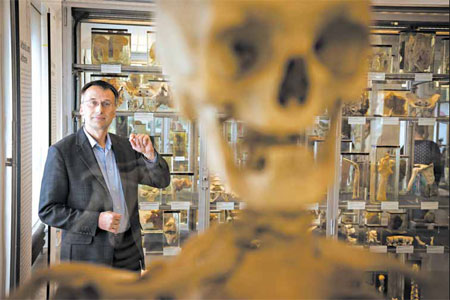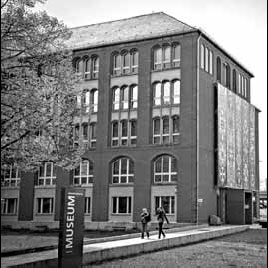Skeletons get ticket home
Updated: 2013-06-02 08:01
By Doreen Carvajal(The New York Times)
|
|||||||
|
Thomas Schnalke, director of the Museum of Medical History in Berlin, helped write new guidelines on how to handle human remains. Gordon Welters for The New York Times |
|
The Museum of Medical History in Berlin, which has more than 5,000 skulls in storage, recently returned 33 skulls and skeletons to Australia in a simple ceremony. Gordon Welters for The New York Times |
Berlin
For more than a century, the Museum of Medical History here has exhibited assorted limbs, bones, tubercular lungs and fetuses, all in the name of science and enlightenment. Yet lately the curators are re-evaluating the principles that govern their displays as they confront a growing debate over what cultural organizations should be doing to preserve the dignity of the dead.
At the same time, many of the world's grand museums are hearing increasing demands for the return of human remains from conquered peoples. Some are giving back bones and skulls that were once viewed as exotic trinkets and were traded by native peoples for calico or plundered in the late 1800s by scientists exploring racial differences.
In April the medical museum and officials who direct the anatomy collection of a sister organization at the Charite Hospital in Berlin returned 33 skulls and skeletons to Australia and to members of tribes from the Torres Strait Islands between northern Australia and Papua New Guinea. The handover took place in a simple ceremony. Gray cardboard boxes of remains were draped in white and aboriginal flags.
"These are very moving moments for indigenous people around the world," said Ned David, a Torres Strait islander who helps lead a repatriation group and attended the ceremony. "They are bringing their ancestral remains home. There are mixed emotions, one obviously of relief, so it's a celebration. And then the moment is tinged with sadness for what was involved with the removal of the remains."
That same week the German Museums Association issued new ethical guidelines for museums on how to handle human remains in the face of repatriation claims from former colonies where scientists gathered skulls and skeletons under murky circumstances more than a century ago.
In a report sprinkled with references to Kant's concept of human dignity, a commission of lawyers and curators recommended that institutions study provenance systematically and return remains that had been collected as part of a violent conflict. They urged museums to develop a policy and concluded that "there is no simple answer that can
be applied equally to all collections."
In many ways, the German association is drawing on the experiences of museums in Britain and the United States, which started facing claims for the repatriation of human remains decades ago. The Smithsonian Institution in Washington began to repatriate American Indian bones in the late 1980s, and in 1990 the United States passed legislation to enforce the return of those remains by museums that benefit from federal funds. The Smithsonian independently returned remains to Australia in 2008 and 2010.
However, a report in 2011 from the Government Accountability Office still urged new measures to speed up the Smithsonian's work, because by then it had returned only 5,000 remains, about one-third of its collection of such material.
Human remains are held by many of the world's museums, most typically those exploring natural history, science, medicine and archaeology.
Collecting such remains in pursuit of scientific knowledge once went unchallenged, but now institutions face the quandary of how to display Egyptian mummies in a respectful fashion. What is the purpose of displaying shrunken heads or tattooed Maori skulls or bone flutes? And should curators return remains that have been transformed into works of folk art?
In England, the Manchester Museum just issued a six-page statement of its guidelines for its natural history collection that pledges transparency and "respect" for human remains. It is looking to transform old exhibitions to reflect new attitudes by, for example, offering more information about the lives of people preserved as mummies, so they can be viewed as individuals instead of specimens.
Experts on the repatriation issue say that it appears that many museums are growing more sensitive. "There's a lot of work to do," said Paul Turnbull, a history professor at the University of Queensland, in Australia, who has studied the use of indigenous remains. "But there is a trickle effect. When museums are contacted, they are now willing to talk."
Australian diplomats say that even France's traditionally bureaucratic museums are trying to streamline the process by creating a commission to develop a system to avoid passing national legislation for each return.
Some say they are concerned that repatriation could hamper scientific studies, particularly as developments in DNA research permit scientists to draw more information from ancient remains.
"The danger is that museums will no longer explore because they will have other priorities," said Tiffany Jenkins, a sociologist and author of "Contesting Human Remains in Museum Collections." "There's a whole host of research that isn't being done because it's too sensitive."
The repatriation debate has been particularly unsettling in Germany, where demands for the return of skulls from Namibia have reopened a dark chapter of Germany's brief colonial history in southwest Africa, where thousands of rebellious members of the Nama and Herero tribes were killed by German troops in 1904. Some human remains were later used by German scientists in discredited scientific studies that aimed to document the racial superiority of Europeans over indigenous tribes.
Today officials at the Museum of Medical History - which has more than 5,000 skulls in storage - say the new German guidelines are just the beginning of an evolving process that emphasizes evaluating each claim individually within a moral framework.
Thomas Schnalke, the museum's director, who helped devise those standards, said he knows that returns stir uneasiness among museums, which worry that such repatriation could intensify demands for looted art objects, too. "There is anxiety that it might open the gates," he said. So far, he added, the "avalanche effect" has not happened, and the reparations have aided a "healing process."
He cited the museum's ceremony for the return of remains in April. It was, he said, surprisingly moving because of its stark simplicity: no flowers, no music, "just pure words" of loss and homecoming.
The New York Times
(China Daily 06/02/2013 page9)

